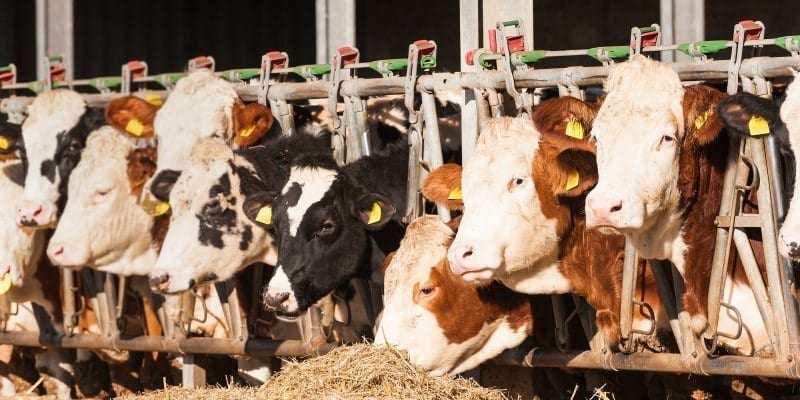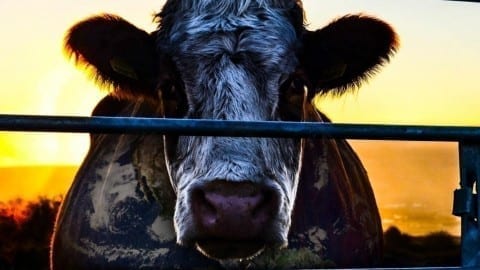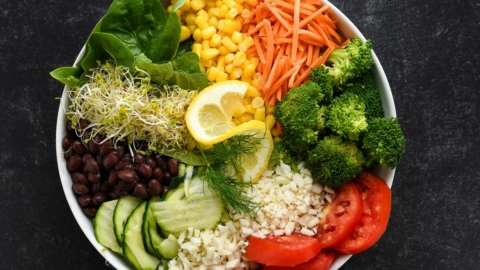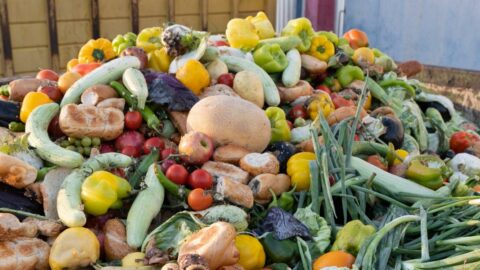Most of us happily eat three meals a day, possibly giving consideration to calories or fat, but usually not thinking about the impact our food choices have on climate change. We may feel guilty about driving a gas guzzling car or good about driving an electric vehicle, but in reality, your car doesn’t have the biggest personal impact on the environment, your diet does. Animal agriculture is responsible for more greenhouse gas emissions than all transportation emissions combined.
Dietary habits are some of the most ingrained facets of cultural experiences throughout the globe. In America, we pride ourselves in our regional styles of barbecue, burgers, and fried chicken. Among the top-10 most consumed foods in America are hamburgers, hot dogs, pizza, and chicken tenders. Unfortunately, each of these is on the list of foods with the greatest environmental impact.
Based on the amount of meat and dairy products we consume, we could eliminate fossil fuels entirely—converting all of our energy to wind and solar—and we’d still exceed our 565 gigatonnes Co2 limit by 2030. Popular media outlets would like us to believe that we can reduce climate change with solar panels and hybrid vehicles. In truth it starts with what we cook for dinner, and even small changes can make a huge impact.
Try Going Vegan, Vegetarian, or Mostly Plant-Based to Reduce Your Carbon Footprint

Veggie bean and sweet potato burgers with avocado and spinach. Jeni Foto/Bigstock
Based on the science, the simplest and most effective way to make a positive difference is to eat less meat and dairy. All animal products require massive land usage and deforestation, promoting unnaturally high methane emissions, which is 25-100 times more destructive than CO2 on a 20-year timescale. Feed crops for livestock in the United States are responsible for 56% of all water usage, and that’s just what we have to feed the livestock to maintain our current level of production and consumption.
Americans average 270.7 lbs of meat consumption per year. Considering that a single, quarter-pound beef patty requires 52.8 gallons of water for production, the environmental effects of this level of consumption are staggering. If you normally have meat with every meal, try limiting it to once a day and getting protein from vegetable sources instead. If you already limit your meat intake, try cutting it in half. For families, try smaller portions of meat with each meal, and add a plant-based, chocolate-flavored protein powder to the grocery list.
In a culture where habits inform consumption, the hardest part of the transition to eating less meat and dairy is simply imagining your plate without it. This is a new issue, and convincing your grandfather that he doesn’t need a piece of meat for his meal to be complete can be quite difficult, if not impossible. (Trust me, I’ve tried in vain.) Animal agriculture also has some of the largest government lobbying groups in the world, which explains why government regulations pertaining to climate change are focused on transportation rather than the primary cause. It’s up to us as consumers to heed the science and force a market trend toward more plant-based solutions.
If this information shakes you to the core, and you want to eliminate these contributers entirely, going vegan might work for you. For others who want to minimize their carbon footprint, I’d highly recommend starting with small changes and pushing toward a long-term goal of highly monitored meat and dairy consumption. Whatever your favorite dish is, there’s probably a vegan alternative recipe online for you to try. You’d be surprised how tasty vegetable-based entrees can be, and if you enjoy the art of cooking you’ll have a blast making rich, delicious “cheese” out of nuts, and forming black bean and hemp patties for the grill. Plant-based recipes can offer the optimal experience of feel-good cooking.
Foods with the Highest Environmental Impact

Cows eating from feeding trough. Scalatore59/Bigstock
For reference, here’s a list of the foods with the highest environmental impact on climate change per 1kg consumed. When considering which foods to avoid to reduce your personal carbon footprint, this is a good place to start:
- Lamb: 39.2kg CO2
- Beef: 27kg CO2
- Cheese: 13.5kg CO2
- Pork: 12.1kg CO2
- Farmed Salmon: 11.9kg CO2
- Turkey: 10.9kg CO2
- Chicken: 6.9kg CO2
- Canned Tuna: 6.1kg CO2
- Eggs: 4.8kg CO2
Try meal planning using this chart for reference, and see if you can lower your carbon footprint week by week. It’s important that we influence children to understand that a varied, primarily green meal is best for them and the world they inhabit. Infographics with this information are common online. Post one on the refrigerator and let the whole family get involved. It’s easier than retrofitting your home for solar panels, cheaper than buying a new car, and makes a much larger impact.
With emissions from animal agriculture projected to grow 80% by 2050, dietary habits must change if humans are to limit the negative effects of climate change. Americans are second on the list of global meat and dairy consumption, and our totals based on population far outweigh the rest of the world. For positive change to happen, consumers have to make scientifically informed decisions that promote changes in production. We live in a consumer-driven society, so the market will mold itself to consumer preferences to maintain profits. When it comes to food, it’s time to act – not only in the interest of our personal health, but the health of our planet. As the now defunct food pyramid showed us, we can’t rely on the government to tell us what’s best, nor on big industry with vested interests in maintaining profits. In this complex society with many competing agendas around food and agriculture, it’s up to each of one us to educate ourselves so that we can make informed decisions about how our daily diet impacts our health and the environment.
Top Image Credit: Rawpixel
- Film Review | Cowspiracy: The Sustainability Secret - May 10, 2022
- Natural Foot Health for Happy Feet - May 10, 2022
- Vegan on the Go: Finding Vegan Restaurants & Prepared Foods - May 10, 2022











